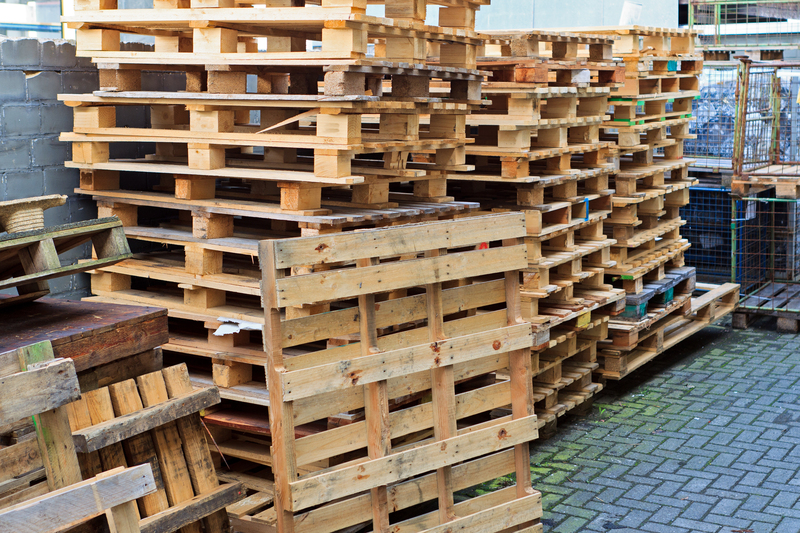Innovative Approaches to Cardboard and Packaging Waste Management
With the global boom in e-commerce and consumer goods, the world faces a mounting challenge: how to effectively manage the ever-increasing piles of cardboard and packaging waste. Traditional methods of disposal are proving unsustainable, emphasizing the urgent need for progressive strategies. In this comprehensive guide, we explore innovative approaches to cardboard and packaging waste management, highlighting sustainable practices, emerging technologies, and real-world solutions that are shaping the future of waste reduction.

Understanding the Scope of Cardboard and Packaging Waste
The surge in online shopping, manufacturing, and retail activity has led to an unprecedented rise in packaging waste--especially cardboard. The Environmental Protection Agency (EPA) reports that packaging makes up approximately 30% of municipal solid waste, with cardboard (corrugated boxes) being a significant contributor.
- Global Generation: The world generates over 400 million tons of paper and cardboard annually.
- Landfill Impact: A considerable volume of usable packaging material still ends up in landfills, contributing to greenhouse gas emissions.
- Recycling Rates: While cardboard boasts relatively high recycling rates (almost 90% in some regions), contamination and lack of collection infrastructure remain barriers.
Why Rethink Cardboard and Packaging Waste Management?
Cardboard waste management goes beyond recycling bins. Poor disposal practices, overpackaging, and non-recyclable additives compromise even the most robust recycling programs. The environmental consequences extend to deforestation, water waste, and increased carbon footprints.
Addressing packaging and cardboard disposal challenges is critical for environmental stewardship and business efficiency alike.
Emerging Trends and Technologies in Cardboard and Packaging Waste Management
1. Smart Packaging and Digital Tracking
Innovations in smart packaging are enabling businesses and consumers to better track the lifecycle of packaging materials. By integrating Radio Frequency Identification (RFID) tags, QR codes, and Internet of Things (IoT) sensors, companies can monitor supply chains, optimize logistics, and ensure that packaging is returned for reprocessing.
- Transparent Traceability: End-to-end visibility streamlines waste collection and recycling.
- Consumer Engagement: Interactive packaging educates end-users about proper disposal and recycling techniques.
2. Circular Economy Driven by Extended Producer Responsibility (EPR)
Governments and industry leaders are implementing extended producer responsibility policies, making manufacturers accountable for the entire lifecycle of their packaging products. This incentivizes the adoption of recyclable designs and the use of eco-friendly packaging materials.
- Design for Recyclability: Producers are encouraged to use mono-materials or materials with compatible recycling streams.
- Financial Incentives: Fees for non-recyclable packaging motivate sustainable material choices.
3. Biodegradable and Compostable Packaging Solutions
Traditional plastic-coated cardboard and some inks hinder recycling efforts. The market now sees a surge in biodegradable and compostable cardboard alternatives that naturally break down in home or industrial compost conditions, reducing landfill burdens.
- Plant-based Coatings: Innovative coatings made from corn starch, sugarcane, or potato starch improve box durability while preserving compostability.
- Non-toxic Inks: Water-based adhesives and inks enhance recyclability and reduce environmental hazards.
4. Automated Sorting and Robot-Assisted Recycling
Automation technologies, including AI-driven sorting robots, are revolutionizing packaging waste management. These systems precisely distinguish between various packaging materials, resulting in cleaner recycling streams and less contamination.
- Increased Efficiency: Robots can operate 24/7, dramatically improving sorting speed and accuracy.
- Labor Optimization: Automation frees workers from hazardous or repetitive sorting tasks.
Sustainable Reduction and Reuse Strategies
1. Reusable Packaging Systems
A move towards reuse, rather than single-cycle recycling, has gained traction in both B2B and B2C logistics. Reusable cardboard packaging is designed for multiple trips in closed-loop supply chains, significantly decreasing the volume of discarded materials.
- Returnable Boxes: Retailers and manufacturers partner on transport packaging that can be collapsed, returned, and refilled.
- Container Pools: Shared use of durable containers among businesses reduces the need for new packaging production.
2. Minimalist Packaging and Material Optimization
The trend toward right-sizing packaging--using only what is necessary to protect products--directly supports sustainable packaging waste reduction. Advances in digital printing and automated cutting machines let businesses custom-fit boxes with minimal excess.
- Size Optimization: Custom dimensions help cut down filler material and shipping costs.
- Lightweighting: Innovations in cardboard structure maintain strength with less material.
3. Community-Based Collection and Recycling Initiatives
Local governments and non-profits are launching community-driven cardboard recycling programs that engage residents and businesses alike. These often involve:
- Dedicated Drop-Off Points: Convenient locations encourage more people to participate in recycling.
- Mobile Collection Units: On-demand pickup services increase recycling rates in urban and rural areas.
- Educational Workshops: Teaching communities about proper sorting techniques minimizes contamination and maximizes recovery.
Case Studies: Innovative Packaging Waste Management in Action
Case Study 1: Closed-Loop Packaging in E-Commerce
A leading global online retailer launched a pilot program using returnable cardboard packages for certain product categories. Customers unpack goods, fold down the sturdy boxes, and schedule free pickups with the delivery provider. Returned boxes undergo quality checks, receive minor repairs, and return to circulation for new orders. Early results show a 40% reduction in waste and significant cost savings over traditional single-use packaging.
Case Study 2: Startups Tackling Cardboard Waste
Innovative startups are creating modular cardboard packaging that businesses can assemble in various shapes and sizes, reducing warehouse stock and leftover scraps. Others are developing water-repellent, rip-resistant cardboard that can be reused up to 10 times before entering the recycling stream--further minimizing waste generation.
Case Study 3: Municipal Composting of Cardboard Packaging
In some forward-thinking cities, local councils collect food-contaminated cardboard along with yard waste for industrial composting. The resulting compost enriches public gardens and green spaces, creating a truly circular system that keeps organic packaging waste out of landfills.
The Role of Businesses in Tackling Packaging Waste
Designing Out Waste from the Start
Businesses wield immense influence over waste footprints through packaging design decisions.
- Mono-material Packaging: Opt for single-material packages that are easier to recycle than composites.
- Easy Dismantling: Ensure products and packaging can be quickly separated for proper waste sorting.
Supplier partnerships and sustainable sourcing drive industry-wide improvements. Collaborating with packaging suppliers that use recycled or responsibly sourced fibers, and adopting closed-system logistics, helps amplify impact across the supply chain.
Engaging Consumers and Creating Incentives
- Loyalty Programs: Reward customers for returning packaging or participating in recycling efforts.
- Clear Instructions: Use labeling and digital tools to educate buyers about proper packaging disposal.
Adopting Zero Waste and Carbon-Neutral Ambitions
Businesses are increasingly setting zero-waste goals and pursuing certifications like CarbonNeutral(R) or B Corp to showcase environmental responsibility. Transparent reporting on packaging waste reduction progress helps build trust and keeps sustainability at the forefront.
Challenges and Opportunities
Barriers to Effective Cardboard and Packaging Waste Management
- Contamination: Food residue, tapes, or labels often render cardboard unrecyclable.
- Inconsistent Infrastructure: Regional disparities in collection and processing make nationwide strategies difficult.
- Market Fluctuations: Prices for recycled cardboard and paper can influence recycling viability.
- Consumer Confusion: Complex packaging formats and mixed materials complicate sorting.
Tackling these challenges demands ongoing investment in education, infrastructure, and technological innovation.
Opportunities for a Greener, Circular Future
- Upcycling: Turning waste cardboard into new products like furniture, insulation, or construction material.
- Closed-Loop Logistics: Supply chains built around reusable, trackable packaging maximize resource efficiency.
- Innovative Business Models: Subscription services offering zero-waste deliveries and packaging buy-back programs are rapidly gaining popularity.
- Digitization: Data-driven insights can optimize packaging design, reduce inefficiencies, and drive behavioral change.

The Future of Cardboard and Packaging Waste Management
As global consumption patterns evolve, so must our strategies for managing cardboard and packaging waste. From smart sorting systems and reusable logistics to biodegradable materials and community action, an ecosystem approach is essential for a truly sustainable future. By embracing innovation and circular principles, businesses and consumers can work together to minimize waste and preserve the planet's resources.
The journey towards innovative, sustainable packaging waste management is ongoing, but its rewards--a cleaner environment, reduced carbon footprints, and smarter resource use--are well worth the effort.
Conclusion: A Call to Action
*Managing cardboard and packaging waste is a shared responsibility.* Businesses, policymakers, and consumers all play vital roles in driving the adoption of cutting-edge solutions. By supporting innovative approaches--from eco-friendly designs and smart collections to education and digitization--each of us can contribute to a circular economy and a greener, cleaner world.
- Choose products with minimal, easily recyclable packaging.
- Support brands and retailers committed to sustainable packaging practices.
- Participate in local recycling and zero-waste initiatives.
*The future of cardboard and packaging waste management is in our hands. Let's innovate, collaborate, and take action--today.*